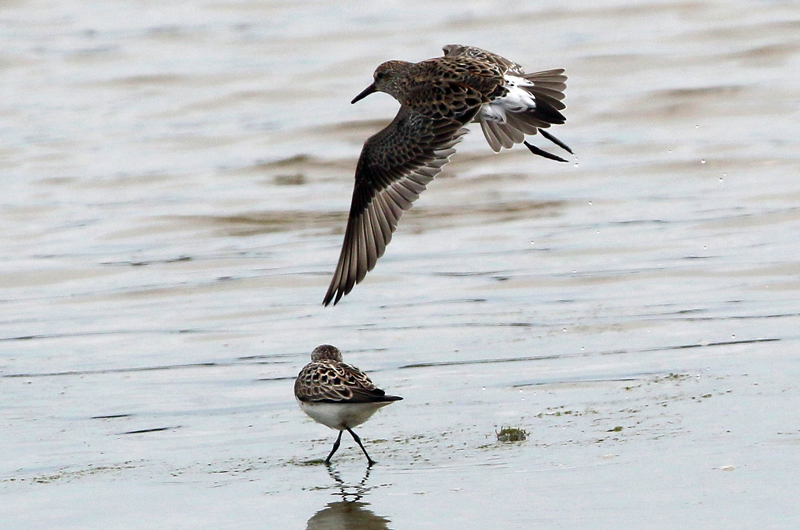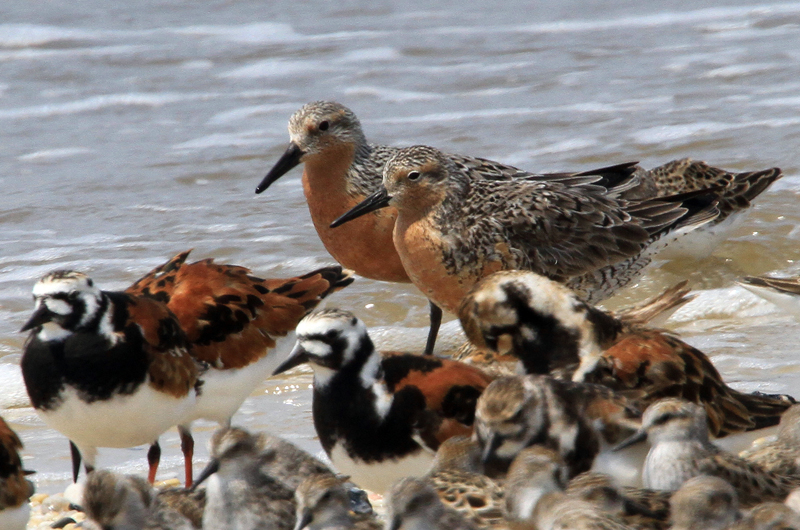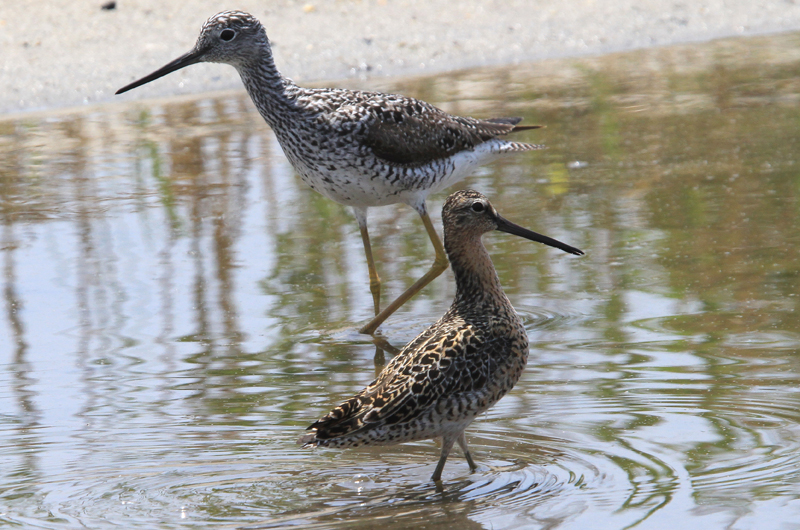Migrating shorebirds have been scarce so far this month; we have observed relatively few other than the ones that either spend the winter here or breed here. This lateness may be due to the cold ocean and the windy wet weather that seems to have predominated in May. But now they are here, en route to their Arctic breeding grounds.
White-rumped sandpipers are fairly difficult to identify. They are slightly larger than other smallish sandpipers, and their hind-end appears to be pointed because their wings extend beyond their tails. And of course, given their name, the white on their rump goes all the way across and is not interrupted by a black stripe in the middle. Lanny McDowell, Pete Gilmore, and Warren Woessner picked out two white-rumped sandpipers from a flock of semipalmated sandpipers and sanderlings.
Short-billed dowitchers are also passing through. Jeff Bernier found at least one of them on the tidal flats of Norton Point Beach on May 27.
Ruddy turnstones are frequent on our beaches. Multiple observers have seen these striking shorebirds on Norton Point Beach and Little Beach. There is a reason for their being called turnstones, and my Saturday morning guided birding tour got to see them at Sarson’s island turning stones over to get the food items hiding underneath.
Red knots seem to be more common than usual for this time of the year. Walt Looney had a flock of eight mixed in with other shorebirds on Norton Point Beach on May 26. The trio of Lanny McDowell, Pete Gilmore, and Warren Woessner also observed them there on May 28, as did Jeff Bernier on May 24. I observed a couple of them at Little Beach and on Sarson’s island on May 27. Cold ocean temperatures have delayed horseshoe crab breeding this year in Delaware Bay, and the knots that normally use those super-abundant eggs to fuel the last leg of their migration to the Arctic seem to be spreading across the Northeast to find their food.
The dunlin and black-bellied plovers that we see at this time of the year are very distinct from our winter residents of the same species. Now most of them are in their full breeding plumage rather than their dull wintering plumage. Both species can be found on pretty much any of our tidal flats.
Bird Sightings
The most unusual sighting this week is an immature male king eider, found on May 23 by Rob Bierregaard and Ian Macleod off East Beach just north of Wasque. This species is seldom seen in Vineyard waters. They also spotted a late-to-leave harlequin duck off the Gay Head cliffs.
Usually cuckoos are heard but not seen, but both species were observed this week. On May 26 Doreen McCabe photographed a yellow-billed cuckoo perched out in the open in a cherry tree that has yet to leaf out. And on May 28, Matt Pelikan observed a black-billed cuckoo flying out of a tree in his backyard, with a robin in hot pursuit.
Allan Keith enjoyed the good weather that we had on May 28 and went to Squibnocket, where he found a Philadelphia vireo in full breeding plumage. This species is an unusual sighting in the spring. He also found two redstarts and in the ocean there were a few late seabirds: 20 immature common eiders, 60 black scoters and a few northern gannets. David Padullo found a male red-breasted merganser in Sengekontacket Pond near Felix Neck on May 27. This is another of our winter resident ducks that is hanging around later than usual.
And now we leave migration and look at the breeding season. Martina Mastromonaco observed a belted kingfisher perched atop the clay formations at Lucy Vincent Beach on May 24. It had a stone in its bill, and so was likely excavating a burrow for its nest.
Jeff Bernier found a saltmarsh sparrow in one of the salt marshes along Norton Point Beach on May 24.
Norma Holmes visited Great Rock Bight on May 27 and saw a number of species that breed there, including four warblers: blue-winged warbler, redstart, prairie warbler, and common yellowthroat. She also observed eastern wood pewee, great-crested flycatcher, red-eyed vireo, and cedar waxwing,
Other birds were harassing a screech owl it when it flew into Heather Rynd’s window at 9 a.m. on May 23. She protected the owl from its tormentors, and, fortunately, it recovered after about 20 minutes.
And Gus Ben David reports that he has two male wood ducks that are regular visitors to the ponds in his yard.
The spring northward migration is slowing down and the breeding season is in full swing. Please keep us up-to-date by reporting your sightings to birds@mvgazette.com.
Robert Culbert leads Saturday morning guided birding tours and is an ecological consultant living in Vineyard Haven.











Comments
Comment policy »